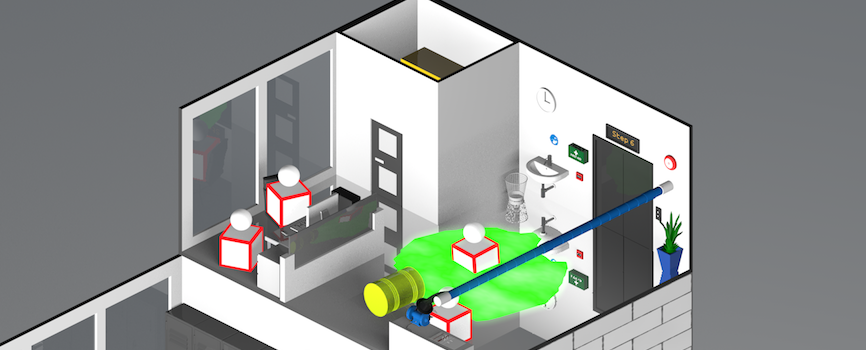5 simple strategies for workplaces to implement for better mental health
Posted 3 years ago
Lottie Galvin, a Mental Health First Aider at iHasco, provides 5 simple strategies for all workplaces to implement for better mental health and wellbeing.
Hey guys, my name is Lottie, I’m one of iHasco’s Mental Health First Aiders, and I’m going to chat to you for a few minutes today about mental health and about 5 simple strategies that you can easily implement at work that can make a lasting difference to the mental health and wellbeing of you and your colleagues if you use just one simple rule – consistency.
We’re creatures of habit, so if you can use what you’ll learn today and turn them into daily practices, you’ll not only lift your own mood on a regular basis, but you’ll help lift everyone else’s too. And as happy employees are loyal and productive employees – it’s a win-win for everyone, and well worth a little time, attention and budget.
Mental Health Awareness Training
First of all, if you have absolutely no idea where to start, you can offer your staff mental health awareness training. It’s not uncommon for management to struggle with this topic.
And I’ve found even employers that are really keen to support their staff can struggle with how to start a sensitive conversation. So training starts that awkward conversation on your behalf, all YOU have to do is provide the opportunity. Online training is a great option because it’s time efficient and cost-efficient. And good quality training will raise awareness of poor mental health as well as good mental health, it will empower trainees to recognise signs of this in themselves and others, and it will offer simple tools and resources to help trainees manage and improve their wellbeing.
It’s great because it can put the whole company on the same page, and there’s a really good chance it’ll start to wipe away the taboo that’s attached to this subject – and open conversations can start happening. And in our experience here at iHasco, this has boosted morale, it’s inspired ideas, it’s strengthened working relationships and it’s led to a more understanding working environment which means everyone actually enjoys their work more.
Encourage hydration and healthy eating
The second thing you can do is encourage hydration and healthy eating – weirdly, this is so simple that many people are guilty of not actually giving food enough credit for the good it can do or the damage it can cause – that’s to our physical health, our energy levels, and our mood.
So, you can help by supplying a little fresh fruit every Monday for example, or by putting a few healthy recipe books in the staff kitchen and encouraging people to read them. Or you can consider a group agreement to bring in something other than cakes on each others’ birthdays! Roughly 1 and a half to 2 and a half litres a day is the recommended water intake to keep the body and brain ticking along happily, so a reminder poster in the work kitchen could be all it takes.
Encourage regular breaks
Number 3 is just as simple – encourage people to take regular breaks. Short and sweet is often the name of the game, but I appreciate that some working environments are very fast-paced and this makes it challenging for employees to pause. But it is so important and it shouldn’t be underestimated.
Even taking just 5 minutes here and there to stretch your legs or switch tasks means your body is moving and this reduces the chances of aches, pains, headaches and tiredness at the very least – all of which can really affect our mood.
Sometimes our eyes just need a break, so the 20-20-20 rule which is a good one to remember – this means that every 20 minutes, take 20 seconds to look at something 20 feet away. It’s a lot more refreshing than you’d think.
And then sometimes we just need to breathe – by that I mean deliberately rather than automatically. You can use the 4-7-8 technique, which means breathing in through your nose for 4 seconds, holding the breath for 7 seconds, and fully exhaling for 8 seconds.
Posters around the workplace for the 20-20-20 rule and the 4-7-8 technique will remind everyone to just take a moment. And it helps to make your staff feel supported and encouraged to look after their own mental health.
Lead by example
Number 4 is lead by example. We’re all capable of influencing each other, especially when we work closely with others. And if we spend our time being angry, annoyed, rude or impatient, it does filter through. It doesn’t just keep our bad mood alive unless we catch ourselves in the act, it’ll affect the people around us, and it can even encourage them to behave in a similar way. This is why it’s very easy to create a toxic environment in this way.
But it can be stopped and the brain can be trained.
The idea is to swap a negative thought for a positive one – all you have to do is pay attention. So, if you recognise a negative thought when it pops into your head, such as “I hate it when Bob grinds his teeth like that”. You then have the power to decide whether you want that thought to stay or go.
You can choose to think of something else which makes you feel much better such as “this cup of tea tastes gorgeous.” Errrm, I’m a big tea fan obviously so that’s the one I use quite a lot. When practiced daily, this little trick will slowly improve your wellbeing much more than you realise, because your brain is being trained to focus on healthier, happier thoughts. You know, you’re actually slowly rewiring your brain to think positively by default.
And if everyone is encouraged to practise this day by day – there will be much less conflict, moaning and negativity in the room… trust me. But not only that, this will filter into everyone’s personal lives too.
Mental Health First Aiders
And finally, you can go one stage further and send 1, 2 or a few staff members on a training day to become qualified Mental Health First Aiders. There are half a day, 1 day and 2 day options that mean certain staff will be trained to recognise signs of poor mental health within your workplace, they’ll gain the knowledge and confidence that’s needed to have that sensitive conversation with someone who needs it, they’ll know what help is out there so they can help to sign-post people to external support, and they’ll know how to handle emergencies.
They will also learn how to simply stop and listen – and listening without an agenda and without interrupting the person speaking with you is sometimes all that’s needed to turn someone’s day around. Surprisingly simple but it’s really effective. This is actually one of the most valuable things I’ve learned as a Mental Health First Aider myself.
So just to recap, your 5 simple strategies are:
- Provide online mental health awareness training
- Encourage hydration and healthy eating
- Encourage regular breaks
- Lead by example by swapping a negative thought for a positive thought
- And send one or more people on a mental health first aid course
If you’re interested in providing awareness training for your staff you can actually do a free trial of our Mental Health Awareness eLearning course. I spent quite a few months researching and writing this piece and it’s kind of my baby.
And I put my own knowledge and experience into it as a qualified mental health first aider. Our aim was to make a course that was accessible, practical and of genuine use to those that are new to managing their mental health, but it’s also for those that know their stuff but simply need a refresher.
If you’re interested in sending anyone on a Mental Health First Aid course, you can check out the MHFA England website and explore your options.
My colleague Amanda and I did their full 2-day course and we walked away feeling really inspired by the whole. And quite humbled in a way. When you know how, it’s nowhere near as daunting as you think to offer people support and listening ear.
It’s such an amazing feeling actually, when you help someone in need and make a difference to them even in the smallest of ways. Training Amanda and myself as Mental Health First Aiders has made a big difference here in our workplace, you know we’ve helped our colleagues with problems that range from big to small – and it’s really strengthened our team, and the network and the support and the feeling of having a home away from home here.
So that’s all from me for now. If you guys have any further questions about our training courses, please get in touch! And if you’re interested in further tips and tricks and any other information surrounding mental health, please check out our blogs – myself, our other scriptwriters and our marketing team have put a lot of effort into resources that are freely available for you to look at.
Thanks for checking in guys. I hope you’ve found this useful. Catch you soon!

Related articles



Opt-in to our newsletter
Receive industry news & offers